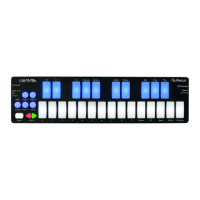3.8.3 Gain, Offset, Curve, Min, and Max
After selecting your source for the MIDI data type, you can then further modify what values you
are sending to your MIDI device/software by using the math modifiers in the next five columns.
Gain: The number in the gain box is used to multiply the raw value coming from the source. For
example, setting the gain number box to “2” will double whatever value is received from the
source. Setting the gain box to 0.5 will cut the value from the source in half.
Offset: The offset is added onto the raw value after it has been multiplied by the gain value.
Curve: The result after the offset is entered into the selected curve’s lookup table and used to
plot the index on a chart. There are a number of table options, each which will affect the value
differently as it increases or decreases. The shape of each curve is pictured below:
There are two user table options that are settable from the View/Edit Tables window that you
can access from the Edit Menu. See the View/Edit Tables chapter below for more information on
setting the User Tables.
Min and Max: These allow the value to be constrained between a minimum and a maximum
number. If the min is set to 10 and the max is set to 15, then the output cannot be less than 10
or more than 15. Anything outside the range of the min and max will be truncated. Note offs will
still be at velocity 0 even if the min is set above 0.
Example: If I want Channel Pressure to control a Filter cutoff but only span half the range of the
filter I could do this two different ways:
1. Set the Channel Pressure Gain to .5 so that you only get half the values. If you wanted
to get the top half of the filter you could set the offset to 63. This would allow you to
output a pressure of 63-127 to the filter.
2. Set Min to 63 and keep Max to 127. This allows an output of 63-127.
While both methods work and set the same range of output values, the first method is probably
a better way to achieve these results. This is because the second method ignores and truncates
the first half of the pressure of your finger on the key. The first method scales the range so that
the whole range of motion is used.
40

